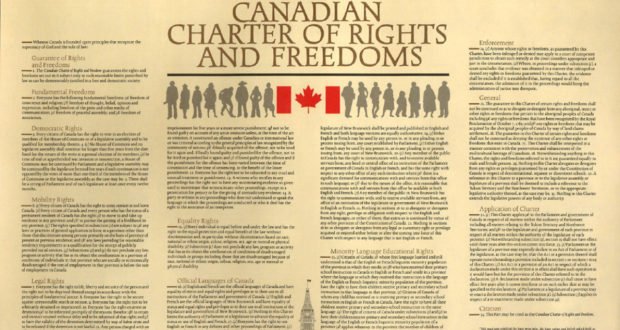Leonid Sirota has written two excellent articles in response to my essay, “The Case for a Constrained Approach to Section 7.” I am grateful for these pieces, firstly, because Mr. Sirota takes the view that my position is “largely misguided,” meaning that he endorses at least some of my views (though perhaps I am channelling Lloyd Christmas a bit on this one); and, secondly, because my original essay was written with its own ‘constraints’ – a word limit, which, incidentally, I exceeded anyway – and I now have an opportunity to flesh out my argument in greater detail.
Mr. Sirota’s first article, cleverly entitled “Seven’s Sins,” critiques my arguments with respect to section 7. His second article, “How to do Constitutional Adjudication,” takes on my suggested approach to constitutional adjudication more generally. There is much to say in response to both these pieces, and indeed, Mr. Sirota and I are not as far apart as it may initially seem. As he says, the devil is in the details.
Since my overarching judicial philosophy of “constitutional supremacy” directly informs my views of section 7 in particular, I will first reply to Mr. Sirota’s second article. My reply to “Seven’s Sins” will follow in short order.
***
Mr. Sirota offers quite a bit to chew on in just over 1000 words, but his argument, as I understand it, boils down to the following propositions: 1) Judges must generally apply the law as written and should work to foster stable legal doctrine, 2) In applying the law, judges cannot avoid making moral and value-laden judgments; and 3) Judicial moralizing is, to a certain extent, desirable due to “democratic process failures,” meaning that the legislative process is not properly responding to the changing will of the people (Mr. Sirota also discusses briefly the circumstances in which courts should be permitted to overrule precedents. Since this was not a central feature of my paper or Mr. Sirota’s response, I will leave this for another day.)
Naturally, I am in complete agreement with Mr. Sirota’s first point. There is little for me to add with respect to what Mr. Sirota eloquently describes as “an inflationary interpretation of constitutional texts that divorces constitutional law from the rules that actually were enacted through the democratic process.”
With respect to Mr. Sirota’s second point, I have no illusions about utterly removing morality, social policy and politics from section 7 jurisprudence, or constitutional jurisprudence in general. The judge can no more divorce herself from her subjective experiences, beliefs and values than can the historian, the economist, or the physician. However, by acknowledging that judges are fallible, it does not follow that judges should embrace their fallibility. As legal historian G.P. Browne put it, “It is not a question of whether judicial legislation can be avoided, but of the extent to which it should be restrained.” The virtue of an approach that remains wedded to the text and settled doctrine is not that it removes judicial bias, subjectivity or moralizing, but rather that it constrains and limits those things. And it ensures that when judges truly are forced to enter the social policy fray, they do so armed with rules and principles rather than simply their own subjective worldview. In effect, it imposes a sort of accountability upon the judiciary. A judge who wishes to legislate his or her own social views can easily do so under the guise of the “living tree.” But if that same judge is constrained by a “rule of law” culture, an expansionist interpretation of the Charter becomes far more difficulty to justify.
Mr. Sirota’s third argument – that democratic process failures justify judicial intervention – is the only point with which I seriously take issue. Mr. Sirota concedes that judges must be bound by rules, but it seems to me that if judges are being tasked with correcting “democratic process failures” to ensure that the law does not become “divorced from reality”, they will, at times, be forced to interpret the Constitution in a manner that is not consistent with the constitutional text or doctrine. Mr. Sirota does not offer a precise prescription for how legal stability ought to be balanced with correcting democratic process failures, but whatever the precise balance, the law would, in some cases, have to take a backseat to judge’s own view of proper social policy.
Thus, at the outset it should be emphasized that a judiciary empowered to correct “democratic process failures” will necessarily be “instrumentalist,” finding and affirming rights that are not supported by the Charter itself, but which, in the judges’ view, make for good social policy. Beyond the obvious philosophical objection rooted in the values of democracy and the rule of law, I see this as problematic for two reasons.
The first, which, in fairness, Mr. Sirota has previously discussed at some length, is that democratic process failures can be difficult to identify in practice. Mr. Sirota posed a number of important questions, each of which deserves careful consideration:
how do we know that we are dealing with a democratic process failure, rather than a mere temporary misalignment between the voters’ preferences and legislation? Can we identify, in advance, areas in which the democratic process is (most) likely to fail? (Michael Pal argues, convincingly in my view, that the law of democracy is one such area. Are there others?) Or, if we seek to identify democratic process failures ex-post rather than ex-ante, how do we do that? Is the failure of a number of bills on a topic a sign that the democratic process is malfunctioning or simply that the majority does not, in fact, support changing the law? And then, inevitably, there is the question of whether courts are able to identify democratic process failures successfully and objectively, especially in the absence of much of a theoretical framework.
The fundamental problem these questions implicitly address is that there is no objective standard to determine when the democratic process has in fact “failed” – when, in other words, legislative action (or inaction) is no longer legitimate. Mr. Sirota refers to the “voters’ preferences” and argues that in the case of Carter (as an example), the democratic process failed because a majority of Canadians were not content with the current law (i.e., a complete ban on assisted dying). But this is a problematic standard. In the face of a complex issue that produces several divergent policy viewpoints, it is rarely the case that a majority of Canadians will be in favour of one single approach (just as a majority of Canadians hardly ever favour one political party). To say that most Canadians do not favour an absolute ban on assisted dying does not mean that most favour another particular law (for example, assisted dying only in the case of certain death). It may be, for example, that a plurality of Canadians favours the status quo over any other specific alternative.
Moreover, this argument appears to misconceive the nature and purpose of our legislatures, which is to represent the people, not to serve as a populist mouthpiece on any given issue. To say that the will of the legislature does not reflect the will of “the people” is simply to say that legislatures do not base their decisions on the polls at any given time and look instead to the national interest. I dare say this is a good thing. Ultimately, if the issue is important to Canadians, they will elect a government that promises to reform the law. In the case of assisted dying, it may be that those who cared most about the issue and took the time to lobby their respective Member of Parliament were in favour of a complete ban. Or it may be the case that our elected representatives studied the issue and concluded that lifting the ban would cause a number of regulatory or other public policy problems that outweighed the deficiencies with the current law.
The second basic problem is that even if we could say with certainty that some form of legislative action or inaction amounts to a “process failure,” the proper response is “so what?” Democracy is not perfect. It is bound to produce gridlock or laws that do not always reflect the temper of the times. It is, to paraphrase Winston Churchill, the worst system except for all the others. That is not to say that we should simply accept the system’s imperfections, but rather that those imperfections should be addressed from within (for example, by expanding the role of private members bills and safeguarding the ability of individual MPs to vote their conscience). There is simply no way to empower the judiciary to address “process failures” without also empowering it to determine for itself when those process failures have occurred and how to correct them. The Supreme Court can draw allusions to the “natural limits” of the living tree’s growth, but in the end a judiciary that has authority to intervene where legislatures have “failed” will invariably do so without any clearly defined limiting principle.
Mr. Sirota argues that judicial circumspection will not help the legislatures grow a backbone, but I am less skeptical. Canada existed as a free state for over a century before the Charter was enacted, and during that period our elected representatives regularly enacted laws to respond to changing times and social mores, from equal voting rights to decriminalizing homosexuality, none of which necessitated a “dialogue” with the courts. Even in our own time, we have seen that, where the Court refuses to strike down a law and the issue is returned to the democratic process, real change is still possible (for example, the recent repeal of section 13 of the Human Rights Act).
Thus, to the extent Canada is actually plagued by democratic process failures (which is hardly self-evident), judicial interventions would appear to be less a response to this phenomenon and more a contributing cause. By attempting to correct democratic process failures, our judiciary may unwittingly help to foster them, all the while undermining its own role as that of the neutral umpire.
***
In sum, I have no qualms with Mr. Sirota’s point that judges “should not shy away from making the moral judgments constitutional text requires.” Indeed, to the extent the Charter protects a right, judges should vigorously enforce it. What the courts should not do is enforce principles that are not supported by the constitutional text (viewed properly in its entire statutory, historical and philosophical context), while simultaneously reading down those principles that are textually based, such as freedom of expression.
The approach to constitutional interpretation that I advocate is not necessarily one of restraint (though some measure of judicial restraint is almost always in order); but rather one of constraints. Judicial restraint is a self-imposed limitation, whereby a judge is less willing to give effect to a constitutional provision out of deference to democratic lawmakers. Constraints, by contrast, are external limitations that force a judge to act within the bounds of the constitution (or the rule of law generally). Constitutional constraints and judicial restraint often overlap, but they may also diverge, such as where Parliament has passed a law outside its legislative jurisdiction. Judges must be prepared to apply and enforce what is written, but they must remain faithful servants of the constitutional text and the doctrine that has grown up around it. Any attempt to abridge these constraints, even with the best of intentions, will be difficult if not impossible to contain, and the result can only be a weakening of our legal order and, indeed, of our very democracy.
 Advocates for the Rule of Law
Advocates for the Rule of Law




3 comments
Pingback: Constraint and Candour | Double Aspect
Pingback: Constraint and Candour | Advocates for the Rule of Law
Pingback: Seven’s Wonders and Sixty Colours: More on the Interpretation of Section 7 | Advocates for the Rule of Law